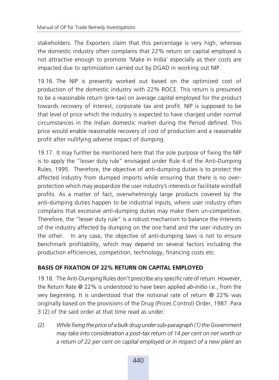Page 463 - MANUAL OF SOP WITH COVER- 04.12.2018
P. 463
Manual of OP for Trade Remedy Investigations
stakeholders. The Exporters claim that this percentage is very high, whereas
the domestic industry often complains that 22% return on capital employed is
not attractive enough to promote ‘Make in India’ especially as their costs are
impacted due to optimization carried out by DGAD in working out NIP.
19.16. The NIP is presently worked out based on the optimized cost of
production of the domestic industry with 22% ROCE. This return is presumed
to be a reasonable return (pre-tax) on average capital employed for the product
towards recovery of interest, corporate tax and profit. NIP is supposed to be
that level of price which the industry is expected to have charged under normal
circumstances in the Indian domestic market during the Period defined. This
price would enable reasonable recovery of cost of production and a reasonable
profit after nullifying adverse impact of dumping.
19.17. It may further be mentioned here that the sole purpose of fixing the NIP
is to apply the “lesser duty rule” envisaged under Rule 4 of the Anti-Dumping
Rules, 1995. Therefore, the objective of anti-dumping duties is to protect the
affected industry from dumped imports while ensuring that there is no over-
protection which may jeopardize the user industry’s interests or facilitate windfall
profits. As a matter of fact, overwhelmingly large products covered by the
anti-dumping duties happen to be industrial inputs, where user industry often
complains that excessive anti-dumping duties may make them un-competitive.
Therefore, the “lesser duty rule” is a robust mechanism to balance the interests
of the industry affected by dumping on the one hand and the user industry on
the other. In any case, the objective of anti-dumping laws is not to ensure
benchmark profitability, which may depend on several factors including the
production efficiencies, competition, technology, financing costs etc.
BASIS OF FIXATION OF 22% RETURN ON CAPITAL EMPLOYED
19.18. The Anti-Dumping Rules don’t prescribe any specific rate of return. However,
the Return Rate @ 22% is understood to have been applied ab-initio i.e., from the
very beginning. It is understood that the notional rate of return @ 22% was
originally based on the provisions of the Drug (Prices Control) Order, 1987. Para
3 (2) of the said order at that time read as under:
(2) While fixing the price of a bulk drug under sub-paragraph (1) the Government
may take into consideration a post-tax return of 14 per cent on net worth or
a return of 22 per cent on capital employed or in respect of a new plant an
440

